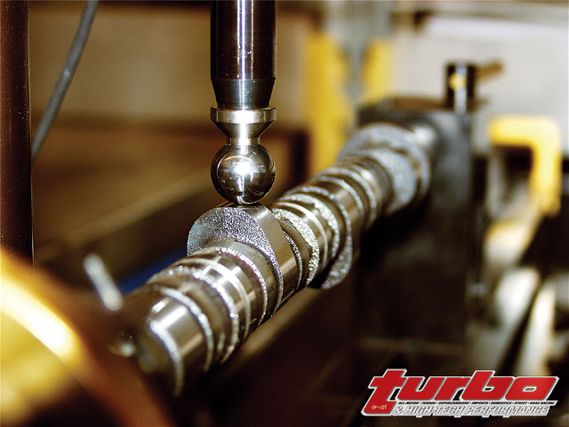 | Higher Energy - Camshafts
| Higher Energy - Camshafts Research, design, manufacture, test; research, design, manufacture, test; research, design, manufacture, test. This repetitious process is necessary to develop the highest quality product. For Skunk2, this is a normal way of life. Each and every product Skunk2 produces goes through a rigorous process of researching, designing, manufacturing and testing. Once the product meets the company's very strict standards it is then, and only then, that the product will be given the go-ahead for production. This commitment to quality is why Skunk2 products are used in high-powered street and race cars throughout the world.
When it comes to designing new camshafts for the K20A engine hundreds of hours of research and development are performed before any product is even tested on Skunk2's in-house DTS engine dyno.
We paid a visit to Skunk2 to check out the company's camshaft testing procedure. The engine on the DTS dyno was completely stock with the exception of a 3-inch intake, Skunk2 race header and Hondata S200 engine management. The combination was good for 244.49 horsepower and 182.14 lb-ft of torque at the flywheel.
One of the biggest challenges the Skunk2 crew faced when designing the K20A camshafts was how well the factory bumpsticks already performed. Unlike the B-series camshafts where there was much room for improvement, the K-series camshafts are fairly-well optimized from the factory. The second challenge Skunk2 had to consider was the K20A2 variable cam timing. Besides the increased valve lift from VTEC, the cam gears on the K20A2 engine are constantly being adjusted by the ECU for maximum performance.
When the engine is under light load and in the lower rpm band the ECU adjusts the cam gears to decrease valve overlap for better low-end power and better emissions. However, when the engine is running under a heavy load and high in the rpm band the ECU optimizes the cam gears to increase valve overlap. By doing so the exhaust gases aid in filling the combustion chamber with charge air caused by a scavenging effect.
With a baseline established, the first camshafts Skunk2 tested was a pair of JDM Type-R camshafts. The camshafts were tested in two stages; the first stage was just running the primary lobes and the second stage just running the secondary lobes (VTEC)
The DTS dyno graph clearly shows the Type-R camshafts performing better throughout the power band when VTEC is engaged, but unfortunately, the increase was only minimal. The factory Type-S camshafts actually performed better until 6300 rpm when the Type-Rs put up better numbers. The Type-Rs only registered a peak gain of 1.79 horsepower more than the stock Type-S camshafts. Although we were happy to see for the first time the USDM market was not getting jacked compared to the JDM market, we were hoping to see the Type-R cams perform much better than what we witnessed.
The second set of camshafts Skunk2 tried out was a set of their own Stage 1s. The Stage 1 camshafts are designed for enthusiasts who want a little more than factory, but don't plan on porting and polishing the cylinder head
On the DTS, the Stage 1 cams generated huge gains on the primary lobes, as high as 13.6 horsepower over the Type-S cams. When the secondary lobes come into play the Type-S bumpsticks actually perform better than the Stage 1 cams until 6400 rpm, where the Stage 1 take over again. The Stage 1 camshafts generated 248.1 peak horsepower, an increase of 6.1 horsepower over stock.
The last set of camshafts tested for the day were a set of Skunk2 Stage 2 cams. The Stage 2 camshafts are designed more for the serious enthusiasts. The camshafts are designed for consumers who plan on building their engine and performing headwork.
On the primary lobes the Stage 2 camshafts torched the Type-S camshafts by 14.04 horsepower, generating 178.09 horsepower at peak. On the secondary lobes we saw the same issues found in the Stage 1 camshafts. But this time the Type-S camshafts performed better than the Stage 2 until 6600 rpm. The Stage 2 camshaft made a dramatic improvement over the stock Type-S camshaft registering 262.29 horsepower, an increase of 17.8. By reviewing the dyno charts you can clearly see the Stage 2 camshafts would have continued to make more power but we didn't rev the stock Type-S camshafts past 8,000 rpm so we weren't able to reference the numbers any higher than that.
This sort of dyno-proven evidence is what consumers should expect out of all performance products they purchase. You want to know your money is being well-spent and that the purported horsepower gains are real. Skunk2's many hours and resources spent on researching, designing, manufacturing and testing these bumpsticks has paid off.
The dyno graphs here are proof positive of their product's worth and merit. They have set the bar high for other manufacturer's to follow, but it is a trend that you, the consumers, will benefit from.
